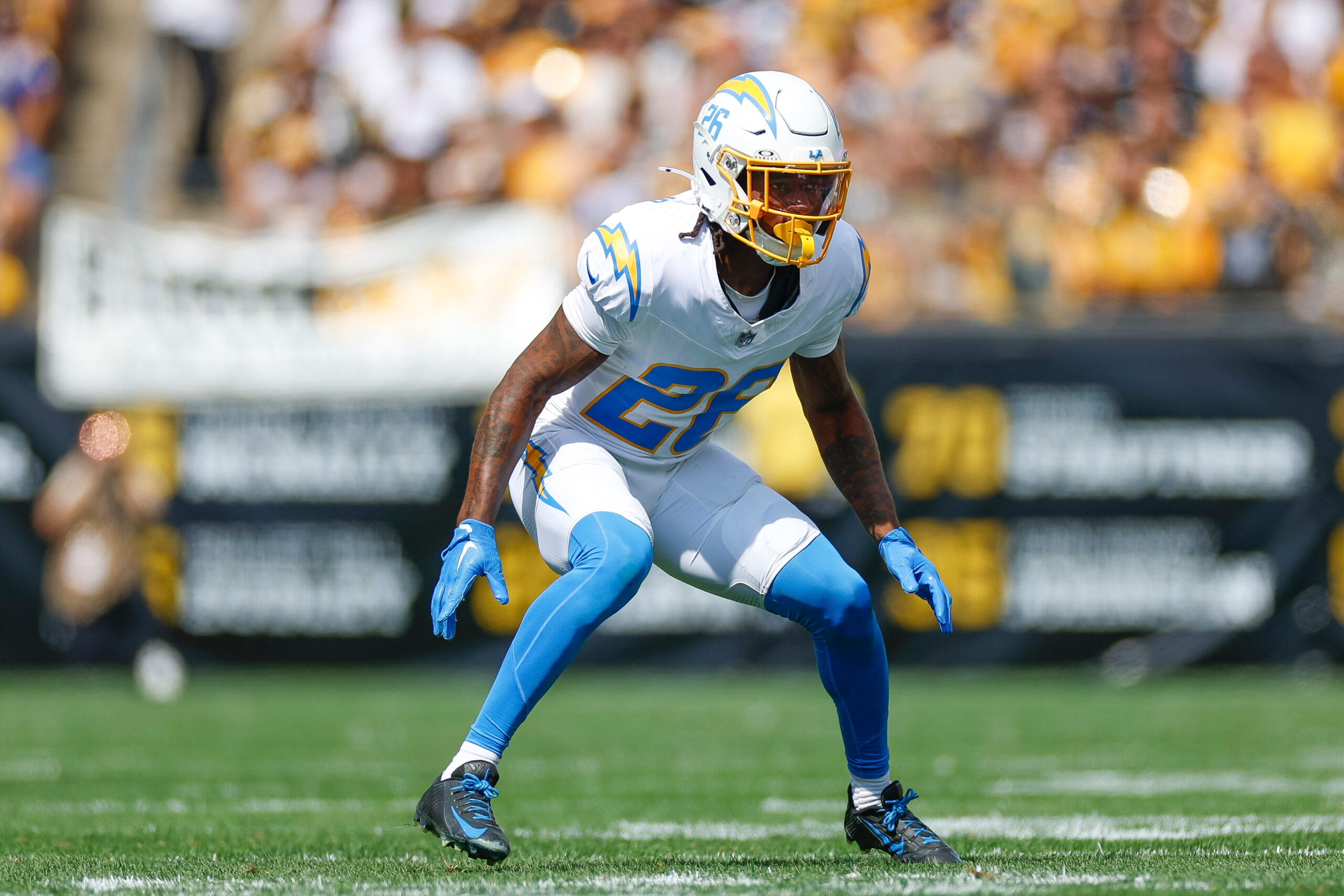Asante Samuel Jr. Faces Career Defining Moment: Will NFL Teams Dare to Risk Health for Talent in This Age of Medical Uncertainty?
Earlier this week, 26-year-old free agent cornerback Asante Samuel Jr., who underwent spinal fusion surgery in April, received full clearance to resume his football career. This significant moment marks a crucial juncture not only in Samuel’s life but also for the teams vying to acquire his services for the remainder of the 2025 season.
As Samuel navigates through multiple visits with interested franchises, including the Carolina Panthers, Green Bay Packers, Minnesota Vikings, San Francisco 49ers, Chicago Bears, and Pittsburgh Steelers, each meeting brings forth a mixture of hope and skepticism. Samuel’s past with the Los Angeles Chargers—where he started 47 out of 50 games and recorded 176 tackles, six interceptions, and 37 passes defended—reflects an impressive career that was unfortunately marred by a lifelong medical condition leading to surgery. His struggle illustrates a broader narrative in professional sports concerning athletes’ physical health and the often unyielding demands of performance, adding another layer of complexity to his current free agency situation.
In the NFL, the pressure for athletes to perform despite injuries continues to rise. Teams are compelled to balance the potential for game-changing talent against the not-so-distant possibility of injury resurgence. For Samuel, this transition from a promising second-round pick to a player looking for a prove-it contract hinges largely on medical assessments and the willingness of teams to bet on his future performance. The scrutiny faced by Samuel is not just about his past; it’s reflective of a larger systemic issue in professional sports, particularly regarding how rehabilitation and medical disclosures influence team decisions.
While many initially pegged Samuel to command a four-year, $45 million deal in the offseason, his recovery from surgery has dramatically altered expectations. What was once viewed as an opportunity for a lucrative contract is now transformed into a more cautious approach, where teams may focus on short-term commitments pending his demonstration of health and performance on the field. This pivot is indicative of the ongoing trend where players with grave injuries face increased scrutiny. Questions linger about their resilience and potential to return to form in the cutthroat environment of the NFL. The narrative surrounding Samuel not only explores the confines of his own career but also illustrates a fundamental tension in professional sports between talent acquisition and risk management.
The medical professionals who greenlit Samuel’s return present an interesting case study on medical ethics in sports. Dr. David Okonkwo, the neurosurgeon who performed the spinal fusion, and Dr. Nicholas Theodore, Director of the Neurosurgical Spine Program at Johns Hopkins University, provided the necessary clearance, raising pivotal considerations about the standards for athletes’ health in relation to their careers. If the medical community endorses a return, are teams obligated to take their assessments at face value? This scenario speaks volumes about the dichotomy between fan expectations, medical interpretation, and business realities—the delicate balance teams must maintain as they strategize for the future.
As Samuel continues his visits, scrutiny is inevitable. His past performance gives teams reasons to be excited, but the specter of injury lingers heavily on both sides of negotiations. Teams like the Chicago Bears will have to evaluate if they want to invest in a perhaps high-reward, high-risk player. With all eyes on the free-agent landscape, Samuel’s situation exemplifies a microcosm of broader discussions concerning player health and labor relations in the sports world. The consequences extend beyond the individual athlete; they resonate with teams’ financials, fan engagements, and the image of the league itself.
Increasingly, the narrative of football is marked by tales of resilience and recovery. Samuel’s quest to prove his mettle this season—admittedly under the heavy shadow of medical history—could serve as a microcosm of a league still grappling with its own identity. What does it mean to be healthy? What does it mean to be deemed fit for the most demanding of professions? As Samuel traverses through the series of evaluations and meets with prospective teams, these questions are at the forefront: Teams are not merely weighing Samuel’s talent; they are reckoning with a future fraught with unpredictable outcomes.
As discussions unfold amongst teams and their medical staff, franchise executives, scouts, and coaches are confronted with ethical dilemmas that test the traditions of the sport against emergent understandings of health. With each visit, each assessment, Samuel’s career trajectory remains poised at a critical intersection where talent, health, and opportunity must converge, representing a crucial point in a narrative that many hope will lead to triumph over adversity.
Trade rumors may float around the NFL during this period, but the focus will undoubtedly remain on Samuel’s condition and its implications for future contracts. The powers of recovery and rehabilitation have never been more prominent, demonstrating how significant advancements in medical science can impact career longevity and trajectories.
As NFL teams weigh the risk versus reward of signing an athlete returning from serious surgery, they must grapple with their philosophical positions on player health. They are posed with questions of their long-term commitments: how do organizations balance immediate needs with the consideration of an athlete’s life and future outside the sport? Moreover, how do they define success beyond just wins on the scoreboard?
The reverberation of Samuel’s decisions will not only echo through his own future but also across the league as a whole. As the professional football framework evolves, a focus on wellness, proactive health measures, and deeper contractual obligations could drive a transformative approach to how teams manage their rosters, from the draft process to free agency. Samuel’s journey can compel the league to look beyond mere statistics and reconsider how they view injury recovery, talent acquisition, and the long-standing ethos of ‘next-man-up.’
This exploration of Samuel’s free agency stage reveals a larger dialogue about the nature of commitment in professional sports, where the stakes are exceptionally high. With a relentless pursuit of victory at the helm of football, players’ health and wellness remain central concerns that will shape narratives not only for Samuel but countless athletes navigating similar journeys. His engagements with teams will inevitably cast light on emerging paradigms within the sport, contributing to a broader re-examination of athlete welfare in an era where successes can often appear ephemeral, contingent upon the fragility of the human body under immense strain.

Earlier this week, 26-year-old free agent cornerback Asante Samuel Jr., who had spinal fusion surgery in April, was fully cleared to play football. He plans to take his time and meet with several teams before deciding where to call home for the remainder of the 2025 season.
According to the NFL Network’s Ian Rapoport, Samuel visited the Carolina Panthers on Wednesday, he’ll meet with the Green Bay Packers on Thursday, and talk with the Minnesota Vikings on Friday. Then on Monday, November 10, he’ll meet with the San Francisco 49ers; on Tuesday, the Chicago Bears will have their chance to make a pitch; and on Wednesday, he’ll be with the Pittsburgh Steelers.
While with the Los Angeles Chargers from 2021 to 2024, Samuel (5’10”, 180) started 47 of the 50 games he appeared in, making 176 tackles, six interceptions, and 37 passes defended.
The former second-round pick spent all but four games last season on injured reserve with shoulder issues, but it was a lifelong medical condition that led to the spinal fusion surgery. Both Dr. David Okonkwo, the neurosurgeon for the Pittsburgh Steelers who performed Samuel’s surgery, and Dr. Nicholas Theodore, the Director of the Neurosurgical Spine Program at Johns Hopkins University, reviewed Samuel’s medical scans and gave him the go-ahead to resume his career.
During the offseason, many considered Samual to be the top corner on the market, with an expected contract to be in the neighborhood of 4 years and $45 million, but since the surgery, he’s probably looking at a prove-it deal for the rest of this season, with the hope of cashing in for 2026 once he shows the NFL he’s good to go.

